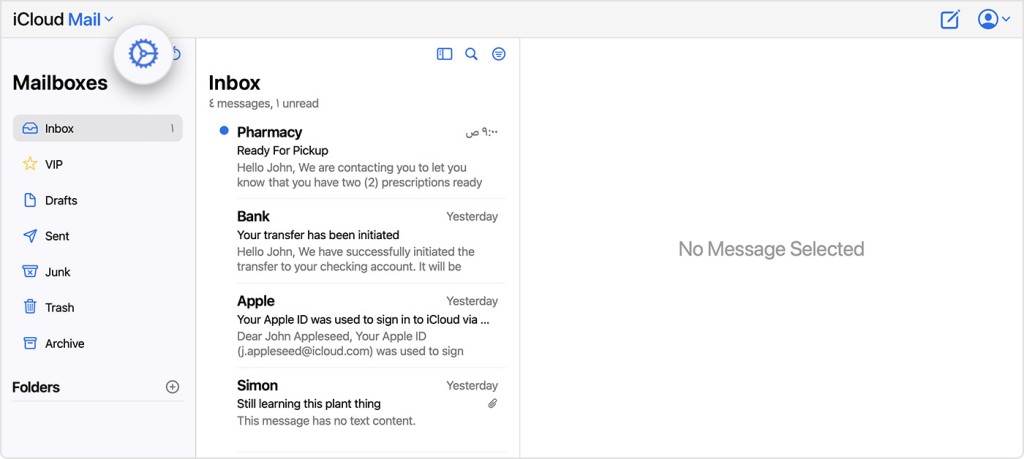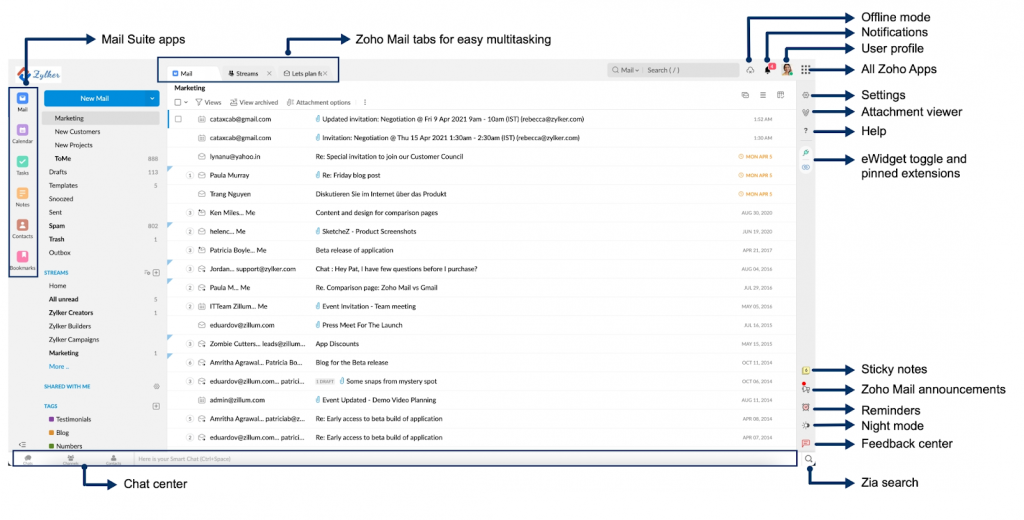- Home
- Comparing Alternatives
- Choosing the Right Email Provi ...

Choosing an email provider may seem like a basic task; however, for marketers, it is a major area of interest. Let’s put it this way: your email service is something that impacts everything, from deliverability and open rates to how well your team performs in general. Whether you’re sending out newsletters, generating leads, or launching full-scale email campaigns, the platform you use can make or break your output.
From this guide, you will learn how to choose the right email provider in 2025, from the must-have features to the top platforms. We will also provide you with screenshots for each platform to illustrate how things work more clearly in each case.
What Is an Email Provider?
That’s simple! An email provider, also known as an email service provider (ESP), is the online tool or platform you use to send and receive emails. For instance, you might think of Gmail, Outlook, or Zoho Mail. Don’t worry; we are going to cover all of these top email providers and more!
However, the ESP landscape has undergone dramatic changes since the dawn of the epoch. Gone are the days when these platforms offered only inbox access. They have now become multipurpose entities that provide plenty of valuable features, such as security, spam filtering, storage, and, in most cases, integrations with other tools.
As a marketer, you should know that the email provider you choose becomes your front line for communication with customers and partners alike. That’s why it’s essential to go beyond the basics and find a service that supports your long-term marketing strategy, not just your inbox.
How Your Email Provider Impacts Marketing Results
Here’s the deal: You might be surprised, but not all email providers are built with marketing in mind. In this case, we deal with a highly multicolored universe. Some platforms offer tight security features that can accidentally flag your messages as spam, which can be annoying. Others are fine with sensible security measures; however, they might lack the ability to integrate easily with CRM or automation tools.
Let’s look at where you can get to when choosing the wrong partners for tango:
🔹 Lower deliverability rates
🔹 Poor contact syncing
🔹 Lack of control over branding
🔹 Trouble collaborating with your team
🔹 Slower campaign execution
On the sunny side of the street, the right business email provider ensures your emails reach inboxes, and by this, we mean not spam folders! The proper ESP also enables your team to work faster and integrate seamlessly with the rest of your marketing stack.
Core Features to Look for in an Email Provider
See, we’re getting closer to insights. However, before we jump into the top ESP options, let’s check out the core features you should look for when looking for a decent email provider:
🔸 Deliverability: By this, we mean the platform’s strong reputation and reliable spam filters. All the ESP tools we’re covering in this review are top business email providers, each with its pros and cons.
🔸 Storage: The bigger, the better, when it comes to the generosity of inbox sizes and attachment limits. For example, Yahoo Mail offers a whopping 1 TB of storage space for emails and attachments, whereas Gmail has only 15 GB of free cloud storage shared among Gmail itself, Google Drive, and Google Photos.
🔸 Security: We believe that the must-haves are, at least, end-to-end encryption, spam protection, and phishing detection. If there’s more, that’s great!
🔸 Integration: Your beloved email provider must seamlessly integrate with your CRM, productivity tools, and other essential digital marketing services.
🔸 Customization: These are branded email domains, signature templates, and various rules. In other words, everything that makes your performance more efficient and work more entertaining!
🔸 Mobility: What should you look for? Here it is: solid mobile experience with native apps.
🔸 User interface: The UI is something that makes the first impression about an email provider. A proper ESP must offer a clean, easy-to-navigate user interface that supports team workflows.
Now, after this quick dive into the ESP core features, let’s break down the best email providers for marketing in 2025. Fasten your belts!
Top Email Providers for Marketing in 2025
Hey, we’re 10% sure that, at this point, you’re wondering, “Which is the best email provider?” Let’s look at our selection of the Great Five regarding the topic of the review:
| Provider | Best for | Benefits | Marketing note |
| Gmail (Workspace) | Google tool users, small and medium enterprises, and teams. | High deliverability and smooth integrations. Great spam filters. | Check it out: the ESP can be even more powerful with tools like Google Ads & Analytics. |
| Outlook.com | Various Microsoft-based entities and larger entities. | Excellent calendar and task integration; ready to scale up to the enterprise level. | The service is great for formal B2B campaigns. |
| iCloud Mail | Apple users and a privacy-focused audience. | Clean UI, ad-free, strong Apple ecosystem. | Best for internal team use or lightweight sending. |
| Yahoo Mail | Budget-conscious customers. | Generous storage (1 TB!), efficient spam filters. | Not ideal for mass marketing, but suitable for basic needs. |
| Zoho Mail | Startups and privacy-conscious teams. | Built-in CRM, low-cost plans, plus a no-ads feature (!). | Excellent for all-in-one marketing and email combo. |
Now, it’s time to browse these email service providers one by one, assessing their advantages and providing a brief marketing tip for you at the end of each section, branded “For your eyes only” to create an exclusive vibe.
1. Gmail (Google Workspace)

⭐ Best suited for: Small and medium-sized enterprises (SMBs), Google Workspace users, and marketers who require integrations. If you’re on the list, consider using Gmail.
✅ Pros:
- Excellent deliverability: In February 2024, Gmail introduced new deliverability rules. Please ensure compliance with these rules to achieve optimal performance.
- It works flawlessly with Docs, Sheets, Calendar, and Meet: Just as it should, as Gmail was designed as part of a larger Google ecosystem.
- The branded domains feature (you@yourcompany.com): Think of something creative, like boss@superIT.com.
- Built-in AI suggestions and Smart Compose: These features can be a great help in developing your marketing content.
✨ A helpful marketing tip: Gmail is one of the most reliable email providers when it comes to avoiding spam folders. If you’re using Google Analytics or Google Ads, it’s a no-brainer because everything syncs effortlessly. Another benefit is that the UI is intuitive and familiar for most users.
2. Outlook.com (Microsoft 365)

⭐ Best suited for: Mid-to-large businesses and Microsoft-first teams. If you are a Microsoft fan and user, Microsoft 365 is an obvious choice. It is even better if you own or work at a larger company.
✅ Pros:
- Efficient scheduling tools and calendar views: The UX is simply perfect.
- Strong security features: Microsoft has designed it with an emphasis on meeting the advanced requirements of larger businesses in this area.
- Easy file sharing via OneDrive: Consider this feature for seamless corporate communication.
- Works well with Teams, Excel, and Power BI: Just like Google, Microsoft offers its own multi-platform solution.
✨ A helpful marketing tip: Please note that Outlook’s email service is more formal compared to other email providers. It is perfect for professional or enterprise-level campaigns. It’s especially good if you are a B2B marketer with Microsoft-heavy tech stacks.
3. Apple iCloud Mail

⭐ Best suited for: Apple community, UI minimalists, and privacy advocates.
✅ Pros:
- Simple, clean design: Apple is very good at developing clean web designs that will please your eyes.
- No ads feature: This is another useful thing that would help you stay focused on your activities.
- Advanced privacy and encryption standards: Again, Apple solutions are very efficient in this regard.
- Free custom email domains via iCloud+: You can use up to five custom domains. Plus, you can also use your personalized email address for Messages, FaceTime, and Calendar. So, instead of name@icloud.com, your address could be name@yourdomain.com.
✨ A helpful marketing tip: While this tool is not made for large-scale marketing, iCloud Mail can work well for teams who use Apple devices exclusively and look for a distraction-free inbox. It’s great for internal updates or brand-building efforts that don’t require mass outreach. If you are an Apple geek, go for it!
4. Yahoo Mail

⭐ Best suited for: Individuals, small teams with basic needs in digital marketing.
✅ Pros:
- 1 TB of free storage: It is a unique, hard-to-beat offer! Yahoo Mail is a clear leader in this field.
- Customizable themes: Enjoy your time working and, at the same time, play with the background and various design elements!
- Built-in travel and receipt organization: You can use this feature when planning your trip to the far side of the world!
✨ A helpful marketing tip: While Yahoo’s deliverability has improved over the years, it is still more popular among consumers than business users. This is why Yahoo Mail is not ideal for CRM-integrated campaigns; you can still use it for segmented, low-stakes email lists.
5. Zoho Mail

⭐ Best suited for: Startups, marketers who want built-in tools.
✅ Pros:
- Ad-free interface, even on free plans: You bet, this is a very good deal! The feature will help you to stay focused on your everyday activities, which is very valuable in our time is money world.
- Native integration with Zoho CRM and Campaigns: The ESP can be your first step into the Zoho universe, enabling seamless job execution.
- Cost-effective with scalable plans: Paid plans start from around $2.70 per user per month in its popular Workplace offer.
- Good selection of collaboration tools (Tasks, Notes, Streams): You can enjoy Zoho’s numerous options in the field of integrations.
✨ A helpful marketing tip: We think that Zoho is a great pick if you want more than just email from an ESP. The CRM and automation tools will make it easy for you to launch campaigns and track lead activity from the same ecosystem.
To Sum Up
Congrats on crossing the finish line of our email provider review! Different email providers serve different purposes, so ultimately, it is up to you to make the right decision.
Let’s summarize: Your email provider is much more than just your inbox. It is your marketing command center. If your team is already using Google Workspace or Microsoft 365, sticking with Gmail or Outlook makes perfect sense. That’s pretty obvious. However, if you’re seeking privacy, simplicity, or budget-friendly options, tools like iCloud Mail and Zoho Mail may be worth considering.
Here’s the bottom line: Choose a provider that syncs with your marketing tools, team structure, and business growth goals. Consider these parameters and make the right choice. The proper email provider can help you land in your customers’ inboxes every time. Go for it!



